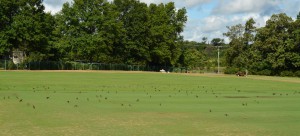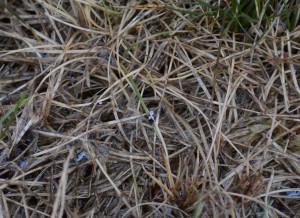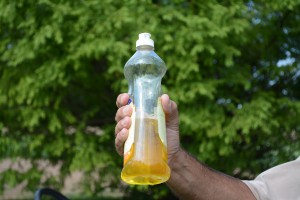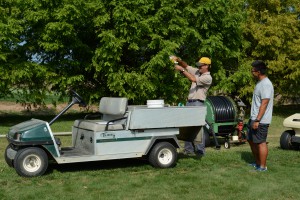Today’s rain got me thinking about insect damage in turfgrass. Actually I’ve been thinking about insect damage in turf for a week or so, ever since I saw a flock of birds pecking sod webworms out of the bentgrass plots behind the Plant Diagnostic Laboratory.
To tell you the truth, I am almost always thinking about insect damage in turf, and then there was a call to action when Brad Park, our sports field management agronomist, and his crew came into the lab with some dead and dying fine fescues…

Poorly performing fine fescue plots on the Rutgers Turf Research Farm. Photo: Richard Buckley, Rutgers PDL
Some fine fescues are very susceptible to summer patch (I think about turf disease a lot as well) and we did indeed find summer patch in some of the samples. In others, however, all we found were a couple of chinch bugs. The population of chinch bugs was small, and because of the sod webworms in the bentgrass, there was concern about them too, so we ventured outside to take a closer look.
Insect damage is often masked during periods of heat and drought in late summer. In fact, we often talk about damage from chinch bugs and sod webworms manifesting when temperatures cool and the rains come in late summer. The change in the weather causes the grass to “wake up” from summer dormancy. The insect damaged areas stay brown as the dormant turf greens up. If after the rain today your grass does not appear to be a little more perky, then a closer look is definitely necessary. Of course, prudence suggests that one might have been paying attention all along, but better late than never!
Take 2 ounces of lemon dish detergent and mix it with 2 gallons of water. Measure out a square yard of turf and pour the solution on the area. Wait 10-15 minutes and see who shows up. Soap flushing irritates the insects, so they emerge from their daytime hiding places in the thatch and soil interface. This technique works very well with webworms, armyworms, cutworms, billbugs and annual bluegrass weevils, and to a lesser degree, chinch bugs. Measuring out a square yard of turf helps to quantify the insect population, which provides data to compare to accepted damage thresholds and make reasoned control decisions.

Eric Chen flushes fine fescue plots. The stakes indicate a square yard area. Photo: Richard Buckley, Rutgers PDL

Cutworms (and chinch bugs–see above) emerge from the soap flushed areas. Photo: Richard Buckley, Rutgers PDL
For chinch bugs, soap flushes work well enough, but the best bet for them is to take a plug and just toss it in a bucket of water. Wait a few minutes and count the critters backstroking on the surface. I like using a golf course cup cutter for this operation. A cup cutter is roughly 1/10th of a square foot, and like the square yard we measured for the soap flush, a known area helps us to quantify the population for comparison to damage thresholds and make solid decisions–data is king!
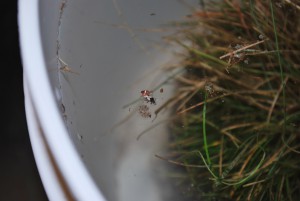
For chinch bugs, toss a plug into a bucket of water to float out the suspects. Photo: Richard Buckley, Rutgers PDL
A smart turf manager will map the damaged areas for scouting next season–before the damage occurs! Monitor the historic hot spots and make control decisions as insect populations build above damage thresholds. Don’t wait to see the damage or use unnecessary preventive treatments for non-existent populations. Remember that ongoing scouting and record keeping are the cornerstones of a solid IPM program. The tools and techniques are so easy to use, even Brad Park can do it!
